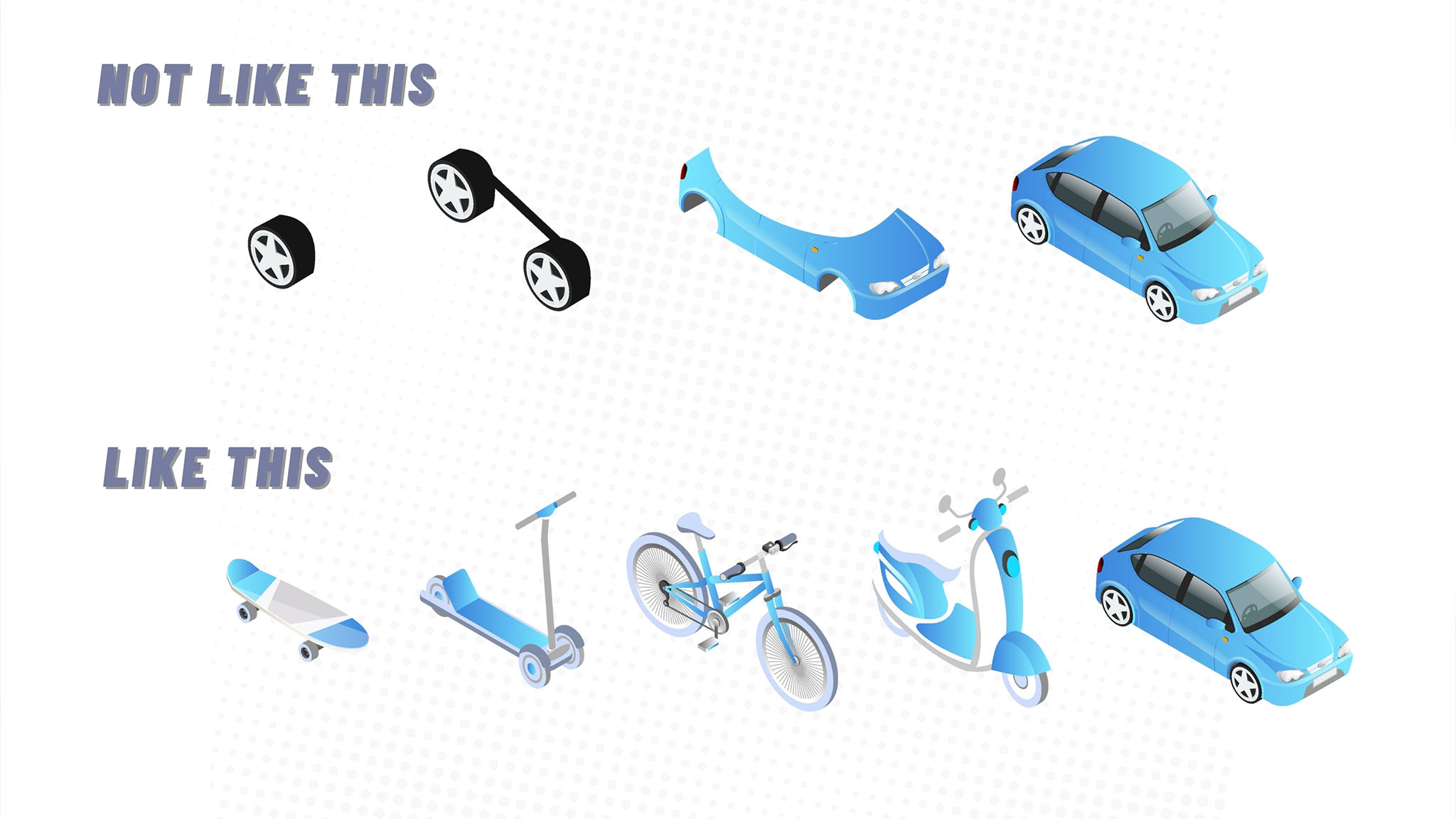
As a technology company, we often meet startups in the conception/idea phase. They expect us to bring their innovative idea to market. Very often it is impossible to make such an assessment on the basis of the information that the creators come to us with. At this stage, we propose to create an MVP or hold a workshop in which the requirements and the development plan are drawn up. In most cases, the creators of the idea hardly know what an MVP really is. It makes sense that the creator of the idea has the knowledge and the plan to go through the MVP phase of its application, so that he or she is more likely to test his or her idea on the market.
What is MVP?
MVP (Minimum Viable Product) is the first working version of the product that has enough features to meet the needs of potential customers and to collect and analyze their feedback on the next product release with minimal effort and resources.
This is a textbook definition that we agree with, but preparing an MVP is only a means to achieve the objective of testing our hypothesis on solving the problem of a particular market segment, and it is precisely on reviewing the solution and talking to potential customers that we should spend most of our time, and MVP itself should help us do that.
The main objective of the MVP execution
As mentioned above, the purpose of creating an MVP is to review our approach to solving a particular market problem. The best way to confirm if our product solves a real problem is to attract some paying customers or possibly build a large community around our product. With the first customers, we will get feedback from them on what they think of our product, and we will be able to improve our MVP version agile, depending on what our customers want.
Common errors when creating and validating MVP
When working on an MVP and validating an idea, creators make simple mistakes that make the process of feedback from the market less effective. Below we have compiled a list of the most common errors:
- Too small test sample - Carrying out market studies on too small a selection of potential customers leads to false results. There is no middle ground about how large the sample should be (the bigger the better), but it can be very risky to develop a technological product based on the feedback of 3 people.
- Market exit with a predetermined result - When we meet with potential customers, we very often come up with a thesis imposed by us. Most of the time we come to a conversation with the customer with the idea that our product will be valuable in the form we invented, and during the meeting we try to prove it by force. There is a big mistake, and we should start with the customer, with their needs and actually think with them about how to solve their problem.
- Only rely on friends - Idea makers often start interviews with friends. This is not a bad step, but remember that information about friends can be wrong, because they may see our idea differently, because they don’t want to offend us. For this reason, the vast majority of our audience should not be known to us, and if we really want to ask the opinion of friends, we should point out that we expect an honest answer from them.
- No prefabricated questions - In meetings with potential clients, the absence of a “talk script” or a structured survey may lead to incorrect feedback. Ideators often come to meetings unprepared and ask general questions such as “Is my product cool”, “What do you think of my product?” The lack of a structured survey makes it more difficult to analyse the information collected.
- Create everything from scratch - For the creation of the first version of our product, it is worth using ready-made solutions. Modules such as sign-in, recurring payments, in-app purchases, etc. can be replaced by ready-made solutions. So we can fully focus on the domain elements of the app.
What is it worth doing before working on an MVP
As a first step, it is advisable to contact a few people who have a problem that we want to solve before starting work. At this stage, we should not focus on our application, but on understanding the client’s problem and, for example, how they tried to solve the problem. If we better understand our client’s problem or challenge, we can offer them a better solution by knowing what is really important to them.
What it is worth asking potential customers
- Are the problems/market needs we have identified and are they relevant for customers? Another very important question with which we want to make sure that the product we propose is the answer to your needs.
- Does the technological solution we propose solve your problems/needs? Kolejne bardzo ważne pytanie, poprzez które chcemy upewnić się, że proponowany przez nas produkt jest odpowiedzią na potrzeby.
- Will customers be able to pay the proposed price for solving the problems/needs by the proposed technological solution? One of the most important questions for our business model. We need to make sure customers want to pay for our product.
- Would solving the problems/needs add value to the company or reduce costs? A very important question for building a business model. If the implementation of our product brings an additional profit for the customer, e.g. 1000$ per month – then the customer will certainly be able to pay 500$ per month. If the implementation of our product results in a cost reduction of 100$ per month, the customer will certainly not be able to pay 500$ per month.
- How have customers tried to solve these problems and needs so far? There are usually many concepts for solving a particular problem. Ask your potential customers if they have tried to solve the problem in another way.
- Have customers ever heard of similar competing technology solutions – if so, why haven’t they implemented them? This question will help us to find competitive solutions that we did not know about before. We also learn about the disadvantages of these solutions if our potential customers have not decided to implement the solution.
- Do you want to become beta testers for a technological product in the early stages of a prototype? If the prospective customer agrees, we have the first beta tester.
What should the MVP version of the product contain?
After we have had initial discussions with our potential customers, we can think about the specification of our MVP. Please note that the MVP version of our product should contain only the most important elements of the application that allow us to verify if our idea is really valuable to the customer and if they are able to spend money on our solution.
When planning the amount of work you should ask yourself, “What exactly will the customer be able to pay?” and you should first prepare only those elements and discard the rest of the less important things.
Example of creating an unusual MVP
Suppose we have a product idea that helps car sharing companies reduce the cost of servicing, repairing and servicing cars. Most people start thinking about developing an app that allows car-sharing companies to compare, report, tips on possible steps, etc.
The second option is to approach the customers themselves and prepare such reports, calculations and notices yourself. The second solution may not be very impressive, but then we will be able to review our business idea much cheaper. In that case, we can work with our 1:1 customers to see if our solution works with our potential customers, and if we’re safe, we can consider how to automate our work, for example, using an app.
Working with the client 1:1 is an option. We’ve seen cases where a customer initially sold a very large Excel file instead of apps, and only when Excel created restrictions, did they decide to create an application in the form of SaaS. It’s worth considering whether we really need to create an app. Perhaps our MVP will be a simple Excel file with the appropriate formulas.
Summary
Before you spend your savings on a technology product that no one will use, think about it. I know you are enthusiastic about your innovative idea and believe it will be successful in the marketplace. However, keep in mind that it is very hard work to bring innovative products to market (9 out of 10 startups fail). During the implementation, there will be a large number of elements that you are not aware of at this time. Right now, you firmly believe in success – but think for a moment, “What happens if my idea doesn’t work – I’m losing time and money.” How can I find out if my idea works? A well-understood and implemented MIP process will be the first step towards answering this question.



 Office Rzeszów (HQ):
Office Rzeszów (HQ):